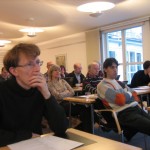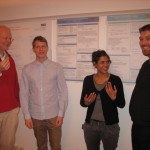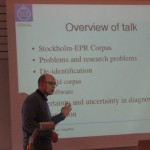A book chapter “Modeling and Managing Business Processes” will appear in the HANDBOOK ON BUSINESS INFORMATION SYSTEMS to be published by World Scientific Publishing. The chapter is a joint effort ofMohammad El-mekawy, Khurram Shahzad, Nabeel Ahmed. The book is edited by:
Angappa Gunasekaran (University of Massachusetts, USA) and Maqsood Sandhu (University of Oulu, Finland)
For more information visit:
http://www.worldscibooks.com/business/7072.html
GSLT-Retreat, Gullmarsstrand, at the West coast, January 26-28, 2009
Sumithra Velupillai and Hercules Dalianis participated at the yearly GSLT, Graduate School of Language Technology Retreat. There where over 50 participants at the conference; PhD-students, supervisors and alumni from the whole of Sweden, see here for the conference programme.
DSV/KTH-Stockholm University is part of GSLT. At DSV we have one more GSLT PhD student at DSV namely Atelach Argaw who is supervised by associate professor Lars Asker. Dr. Martin Hassel at DSV is also one of the GSLT supervisors and he is also supervisor of Sumithra.
Sumithra presented two posters, one with title Mixing and Blending Syntactic and Semantic Dependencies. The research was been carried out during a GSLT phd-course in Machine learning together with the PhD students Yvonne Samuelsson, Oscar Täckström, Johan Eklund, Mark Fishel, Mark and Markus Saers. This poster was also presented at the Coling workshop CoNLL, in August 2008.
Hercules presented our patient data corpus, the Stockholm EPR corpus, and some experiments we have carried out on it.
Some photos from the GSLT-Retreat:
2nd WORLD SUMMIT ON THE KNOWLEDGE SOCIETY, WSKS 2009, 16-18 September, Crete, Greece
I invite my colleagues to contribute with a paper to WSKS 2009 conference. The deadline for paper submission is March 24, 2009. For more information about this conference please access the following link: http://www.open-knowledge-society.org/summit.htm
International Workshop on Value Modeling and Business Ontologies
SYSLAB will organise a workshop on value modeling and business ontologies in Stockholm, Feb 9 – 10, 2009. At this International Workshop, two major approaches will meet: value modeling and REA. The REA (Resources, Events and Agents) model originating from the accounting domain is maturing to a conceptual framework and ontology for Enterprise Information Architectures in general. Value modeling is a business modeling approach that focuses on the value objects exchanged in business networks and that is supported by the e3-value tool set. Although the two approaches differ with respect to their main application areas, their ontologies have a lot in common.
The goals of this VMBO workshop are to bring together researchers with an interest in value modeling, REA systems, or the combination of the two, in order to present and discuss the current state of business modeling and to identify key areas for further research.
VMBO workshop web site
New book on Innovations in Information Systems Modeling

Innovations in Information Systems Modeling: Methods and Best Practices, Edited By: Terry Halpin, John Krogstie, and Erik Proper, ISBN: 978-1-60566-278-7, IGI, link
Modeling is used across a number of tasks in connection to information systems, but it is rare to see and easily compare all the uses of diagrammatical models as knowledge representation in one place, highlighting both commonalities and differences between different kinds of modeling.
TABLE OF CONTENTS
Section I: Conceptual Information Modeling
Chapter I: Enriched Conceptualization of Subtyping
Terry Halpin, Neumont University, USA
Chapter II: Essential, Mandatory, and Shared Parts in Conceptual Data Models
Alessandro Artale, Free University of Bozen-Bolzano, Italy
C. Maria Keet, Free University of Bozen-Bolzano, Italy
Chapter III: Extending the ORM Conceptual Schema Language and Design Procedure with Modeling Constructs for Capturing the Domain Ontology
Peter Bollen, Maastricht University, The Netherlands
Section II: Modeling Approaches
Chapter IV: EKD – An Enterprise Modeling Approach to Support Creativity and Quality in Information Systems and Business Development
Janis Stirna, Jönköping University, Sweden
Anne Persson, University of Skövde, Sweden
Chapter V: Integrated Requirement and Solution Modeling: An Approach based on Enterprise Models
Anders Carstensen, Jönköping University, Sweden
Lennart Holmberg, Kongsberg Automotive, Sweden
Kurt Sandkuhl, Jönköping University, Sweden
Janis Stirna, Jönköping University, Sweden
Chapter VI: Methodologies for Active Knowledge Modeling
John Krogstie, IDI, NTNU, Norway
Frank Lillehagen, AKModeling, Norway
Chapter VII: Data Modeling and Functional Modeling – Examining the Preferred Order of Using UML Class Diagrams and Use Cases
Peretz Shoval, Ben-Gurion University, Israel
Mark Last, Ben-Gurion University, Israel
Avi Yampolsky, Ben-Gurion University, Israel
Section III: Modeling Frameworks, Architectures, and Applications
Chapter VIII: OntoFrame – An Ontological Framework for Method Engineering
Mauri Leppänen, University of Jyväskylä, Finland
Chapter IX: Concepts and Strategies for Quality of Modeling
P. (Patrick) van Bommel, Radboud University Nijmegen, The Netherlands
S.J.B.A. (Stijn) Hoppenbrouwers, Radboud University Nijmegen, The Netherlands
H.A. (Erik) Proper, Capgemini, The Netherlands
J. (Jeroen) Roelofs, Radboud University Nijmegen, The Netherlands
Chapter X: Service Oriented Architecture: A Research Review from the Software and Applications Perspective
John Erickson, University of Omaha, USA
Keng Siau, University of Nebraska-Lincoln, USA
Chapter XI: Designing Web Information Systems for a Framework-based Construction
Vítor Estêvão Silva Souza, Universidade Federal do Espírito Santo, Brazil
Ricardo de Almeida Falbo, Universidade Federal do Espírito Santo, Brazil
Giancarlo Guizzardi, Universidade Federal do Espírito Santo, Brazil
Section IV: Selected Readings
Chapter XII: Business Process Simulation: An Alternative Modelling Technique for the Information System Development Process
Tony Elliman, Brunel University, UK
Tally Hatzakis, Brunel University, UK
Alan Serrano, Brunel University, UK
Chapter XIII: An Agent Based Formal Approach for Modeling and Verifying Integrated Intelligent Information Systems
Leandro Dias da Silva, Federal University of Campina Grande, Brazil
Elthon Allex da Silva Oliveira, Federal University of Campina Grande, Brazil
Hyggo Almeida, Federal University of Campina Grande, Brazil
Angelo Perkusich, Federal University of Campina Grande, Brazil
Chapter XIV: Design Principles for Reference Modelling: Reusing Information Models by Means of Aggregation, Specialisation, Instantiation and Analogy
Jan vom Brocke, University of Muenster, Germany
Chapter XV: Examining the Quality of Evaluation Frameworks and Metamodeling Paradigms of Information Systems Development Methodologies
Eleni Berki, University of Jyvaskla, Finland
Master thesis: Using parallel corpora and Uplug to create a Chinese-English dictionary. Defended December 10, 2008
Authors: Hao-chun Xing (EMIS) & Xin Zhang (EMIS)
Abstract
This master thesis is about using parallel corpora and word alignment to
automatically create a bilingual Chinese-English dictionary. The dictionary
can contribute to multilingual information retrieval or to a domain specific
dictionary.
However, the creation of bilingual dictionaries is a difficult task
especially in the case of the Chinese language. Chinese is very different
from European languages. Chinese has no delimiters to mark word boundaries
as in European languages. Therefore we needed Chinese word segmentation
software to insert the boundaries between each Chinese word in order to
correspond with English words. That was one of the difficult issues in our
project. We spend half time on it.
Our parallel corpora consists of 104,563 Chinese characters, that is
approximately 50,000-60,000 Chinese words, and 75,997 English words, mainly
law texts. We used ICTCLAS as the Chinese word segmentation software to
pre-process the raw Chinese text, and then we used the word alignment system
Uplug to process the prepared parallel corpora and to create the Chinese-
English dictionary.
Our dictionary contains 2,118 entries. We evaluated the results with the
assistance of nine native Chinese speakers. The average accuracy of
dictionary is 74.1 percent.
Key Words: Parallel Corpora, Chinese Word Segmentation, Uplug, Word
Alignment Tool
Henkel’s PhD Dissertation – Nov 11 2008

It’s done, the “book” is now written, published, and defended. It’ been quite a journey – starting in autumn 2002, working through two research projects, countless (well, almost) teacher assignments on courses, working on the competing home-project (two kids – 2004, 2006). Although the journey never ends, the disputation defense was a welcomed station on the way. The opponent, Prof. Michel Leonard did a very good job of examining the thesis – and I hope that I was not as clueless at it looks on the picture when it comes to answering the posed questions. (Thanks to Nasrin for taking the great action picture!)
The 1st IFIP WG8.1 Working Conference on the Practice of Enterprise Modeling (PoEM) took place in Kista, November 12-13

Link to PoEM 2008 website.
The conference was jointly organized by the University of Skövde, the University of Jönköping and SYSLAB. The goal of PoEM 2008 was to establish a dedicated forum where the use of EM in practice is addressed by bringing together researchers, users and practitioners. The goals of the conference were to develop a better understanding of the practice of EM, to contribute to improved EM practice as well as to share knowledge and experiences. The conference program consisted of 17 paper presentations addressing original and significant topics of Enterprise Modeling ranging from reports of innovative case studies to laying grounds to novel solutions in terms of methods and tools. The program faatured a keynote entitled “Information, architecture and other costly concepts” by Björn Nilsson, one of Sweden’s most experienced EM practitioners.
The highly interactive program of PoEM 2008 which included joint brainstorming sessions on the emerging topics of Enterprise Modeling attracted 47 participants both from academia and industry. The delegates came from many European contries as well as Canada and India.

Closing discussion, Programme Co-chair Prof. Anne Persson in front
PoEM 2008 proceedings are available on line. You can find information about it at http://www.springeronline.com/978-3-540-89217-5 or access the online version at http://www.springerlink.com/content/978-3-540-89217-5/







